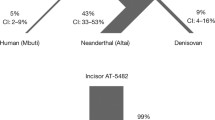Abstract
The application of ancient DNA techniques is subject to many problems caused primarily by low quality and by low quantity of DNA. For these reasons most studies employing ancient DNA rely on the characterization of mitochondrial DNA, which is present in many more copies per cell than nuclear DNA and hence more copies are likely to survive. We used universal and taxon specific mitochondrial primers to amplify DNA from museum specimens, and found many instances where the amplification of nuclear copies of the mitochondrial gene (numts) instead of the targeted mitochondrial fragment had occurred. Furthermore, the likelihood of amplifying numts increased dramatically when universal primers were utilized. Here we suggest that ancient DNA practitioners must consider the possibility that numts can be amplified at higher rates than previously thought. This is another complication for ancient DNA studies, but it also suggests that more extensive inclusion of nuclear markers in ancient DNA studies should be feasible.

Similar content being viewed by others
References
Arctander P (1995) Comparison of a mitochondrial gene and a corresponding nuclear pseudogene. Proc R Soc Lond B 262:13–19
Behura SK (2007) Analysis of nuclear copies of mitochondrial sequences in honeybee (Apis mellifera) genome. Mol Biol Evol 24:1492–1505
Bensasson D, Zhang D-X, Hewitt GM (2000) Frequent assimilation of mitochondrial DNA by grasshopper nuclear genomes. Mol Biol Evol 17:406–415
den Tex R-J, Thorington R, Maldonado JE, Leonard JA (2010) Speciation dynamics in the SE Asian tropics: putting a time perspective on the phylogeny and biogeography of Sundaland tree squirrels, Sundasciurus. Mol Phylogen Evol 55:711–720
Gonzalez-Ittig RE, Gardenal CN (2008) Co-amplification of mitochondrial pseudogenes in Calomys musculinus (Rodentia, Cricetidae): a source of error in phylogeographic studies. Genome 51:73–78
Hofreiter M, Serre D, Poinar HN, Kuch M, Pääbo S (2001) Ancient DNA. Nat Rev Genet 2:353–359
Kim J-H, Antunes A, Lou S-J, Menninger J, Nash WG, O’Brien SJ, Johnson WE (2006) Evolutionary analysis of a large mtDNA translocation (numt) into the nuclear genome of the Panthera genus species. Gene 366:292–302
Kolokotronis S-O, MacPhee RDE, Greenwood A (2007) Detection of mitochondrial insertions in the nucleus (NuMts) of Pleistocene and modern muskoxen. BMC Evol Biol 7:67
Leonard JA, Vilà C, Wayne RK (2005) Legacy lost: genetic variability and population size of extirpated US gray wolves (Canis lupus). Mol Ecol 14:9–17
Leonard JA, Shanks O, Hofreiter M, Kreuz E, Hodges L, Ream W, Wayne RK, Fleischer RC (2007) Animal DNA in PCR reagents plagues ancient DNA research. J Archaeo Sci 34:1361–1366
Mirol PM, Mascheretti S, Searle JB (2000) Multiple nuclear pseudogenes of mitochondrial cytochrome b in Ctenomys (Caviomorpha, Rodentia) with either great similarity to or high divergence from the true mitochondrial sequence. Heredity 84:538–547
Orlando L, Leonard JA, Laudet V, Guerin C, Hänni C (2003) Ancient DNA analysis reveals wooly rhino evolutionary relationships. Mol Phylo Evol 28:76–90
Pereira SL, Baker AJ (2004) Low number of mitochondrial pseudogenes in the chicken (Gallus gallus) nuclear genome: implications for molecular inference of population history and phylogenetics. BMC Evol Biol 4:17. doi:10.1186/1471-2148-4-17
Richly E, Leister D (2004) NUMTs in sequenced eukaryotic genomes. Mol Biol Evol 21:1081–1084
Sambrook E, Fritsch F, Maniatis T (1989) Molecular cloning. Cold Spring Harbor Press, Cold Spring Harbor
Sorenson MD, Quinn TW (1998) Numts: a challenge for avian systematics and population biology. Auk 115:214–221
Tourmen Y, Baris O, Dessen P, Jacques C, Malthièry Y, Reynier P (2002) Structure and chromosomal distribution of human mitochondrial pseudogenes. Genomics 80:71–77
Triant DA, DeWoody JA (2007a) The occurrence, detection, and avoidance of mitochondrial DNA translocations in mammalian systematics and phylogeography. J Mamm 88:908–920
Triant DA, DeWoody JA (2007b) Extensive mitochondrial DNA transfer in a rapidly evolving rodent has been mediated by independent insertion events and by duplications. Gene 401:61–70
Wayne RK, Leonard JA, Cooper A (1999) Full of sound and fury: the recent history of ancient DNA. Annu Rev Ecol Syst 30:457–477
Williams ST, Knowlton N (2001) Mitochondrial pseudogenes are pervasive and often insidious in the snapping shrimp genus Alpheus. Mol Biol Evol 18:1484–1493
Zhang D-X, Hewitt GM (1996) Nuclear integrations: challenges for mitochondrial DNA markers. Trends Evol Ecol 11:247–251
Acknowledgments
Samples were kindly provided by the National Museum of Natural History ‘Naturalis’ (formerly Rijksmuseum van Natuurlijke Historie), Leiden, The Netherlands; the Natural History Museum, London; and the United States National Museum of Natural History, Smithsonian Institution. This project was funded by the Smithsonian Restricted Endowment Walcott Fund and the Swedish Research Council. Logistical support was provided by the Center for Conservation and Evolutionary Genetics, National Zoological Park, Smithsonian Institution, USA.
Author information
Authors and Affiliations
Corresponding author
Rights and permissions
About this article
Cite this article
den Tex, RJ., Maldonado, J.E., Thorington, R. et al. Nuclear copies of mitochondrial genes: another problem for ancient DNA. Genetica 138, 979–984 (2010). https://doi.org/10.1007/s10709-010-9481-9
Received:
Accepted:
Published:
Issue Date:
DOI: https://doi.org/10.1007/s10709-010-9481-9




